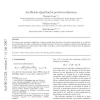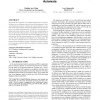516 search results - page 36 / 104 » Generalizing the Discrete Timed Automaton |
EURASIP
1990
14 years 1 months ago
1990
Inversionof multilayersynchronous networks is a method which tries to answer questions like What kind of input will give a desired output?" or Is it possible to get a desired...
COMPGEOM
2006
ACM
14 years 3 months ago
2006
ACM
The k-means method is an old but popular clustering algorithm known for its observed speed and its simplicity. Until recently, however, no meaningful theoretical bounds were known...
SCL
2008
13 years 9 months ago
2008
We observe that successive applications of known results from the theory of positive systems lead to an efficient general algorithm for positive realizations of transfer functions...
PODS
2008
ACM
14 years 10 months ago
2008
ACM
We consider the navigational core of XPath, extended with two operators: the Kleene star for taking the transitive closure of path expressions, and a subtree relativisation operat...
GECCO
2007
Springer
14 years 4 months ago
2007
Springer
This paper introduces a continuous model for Multi-cellular Developmental Design. The cells are fixed on a 2D grid and exchange ”chemicals” with their neighbors during the gr...


